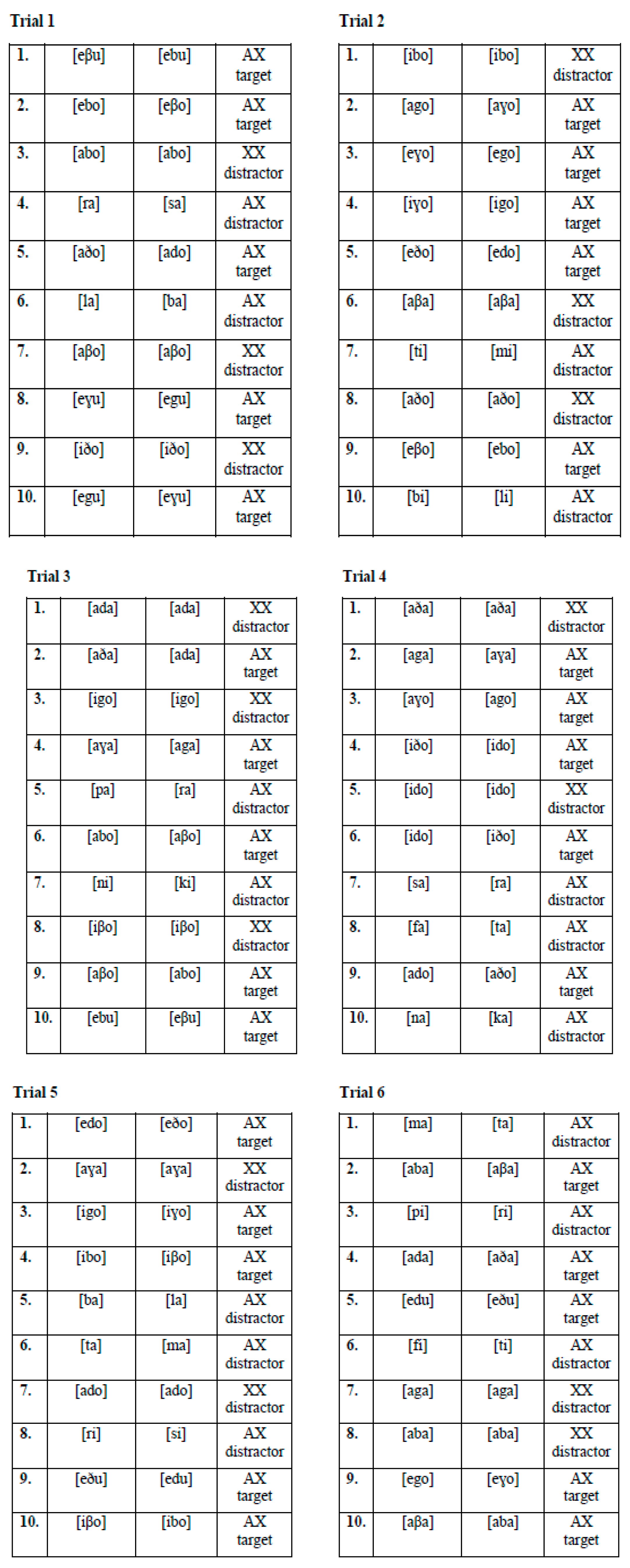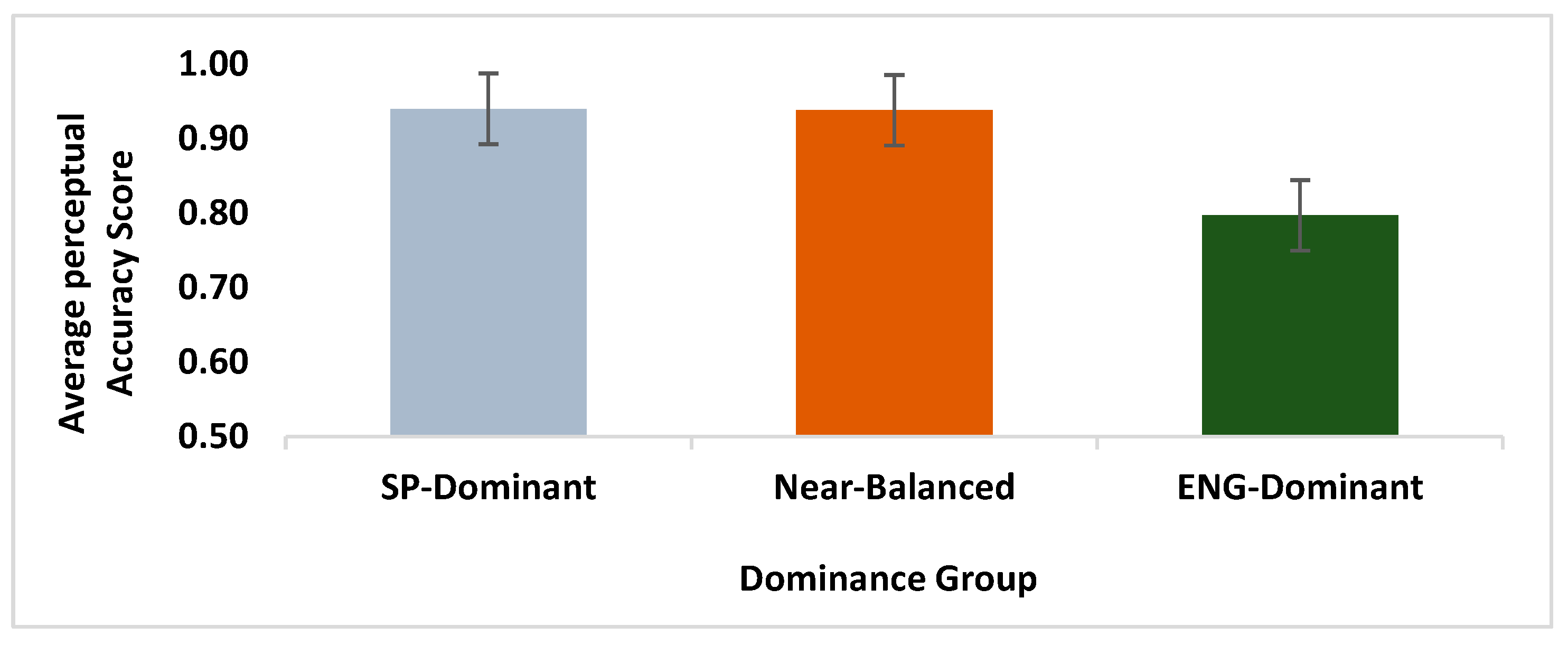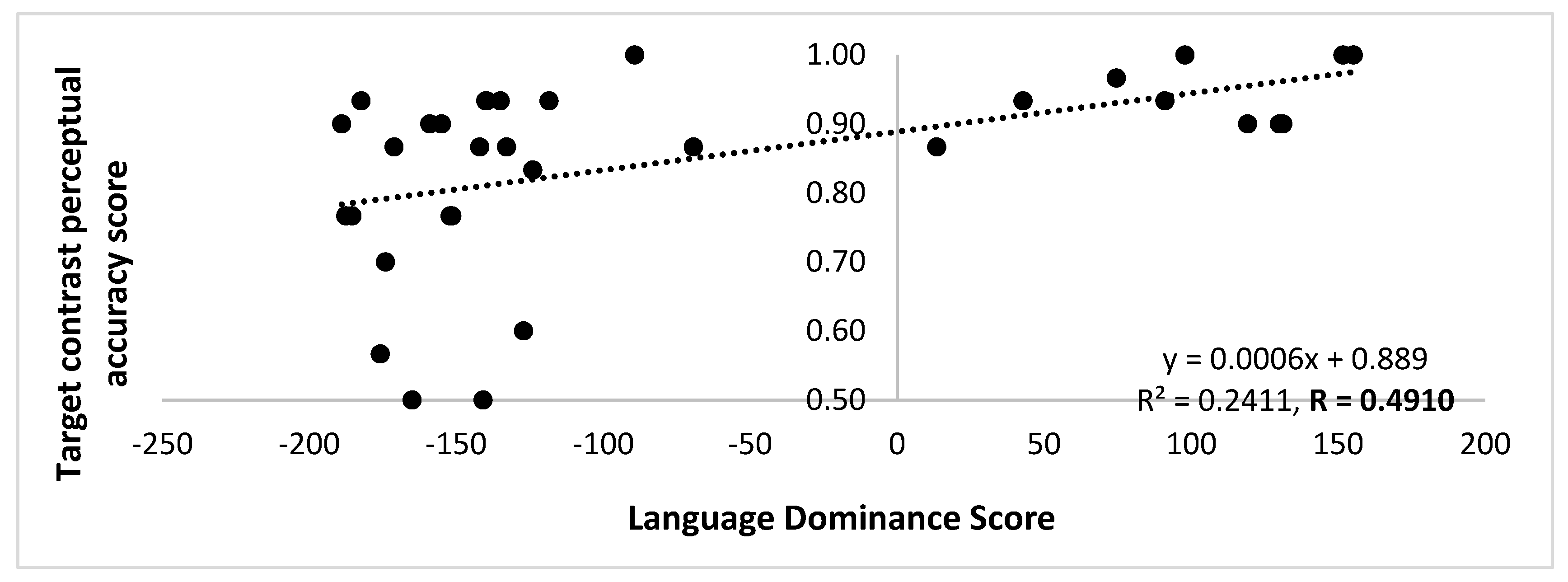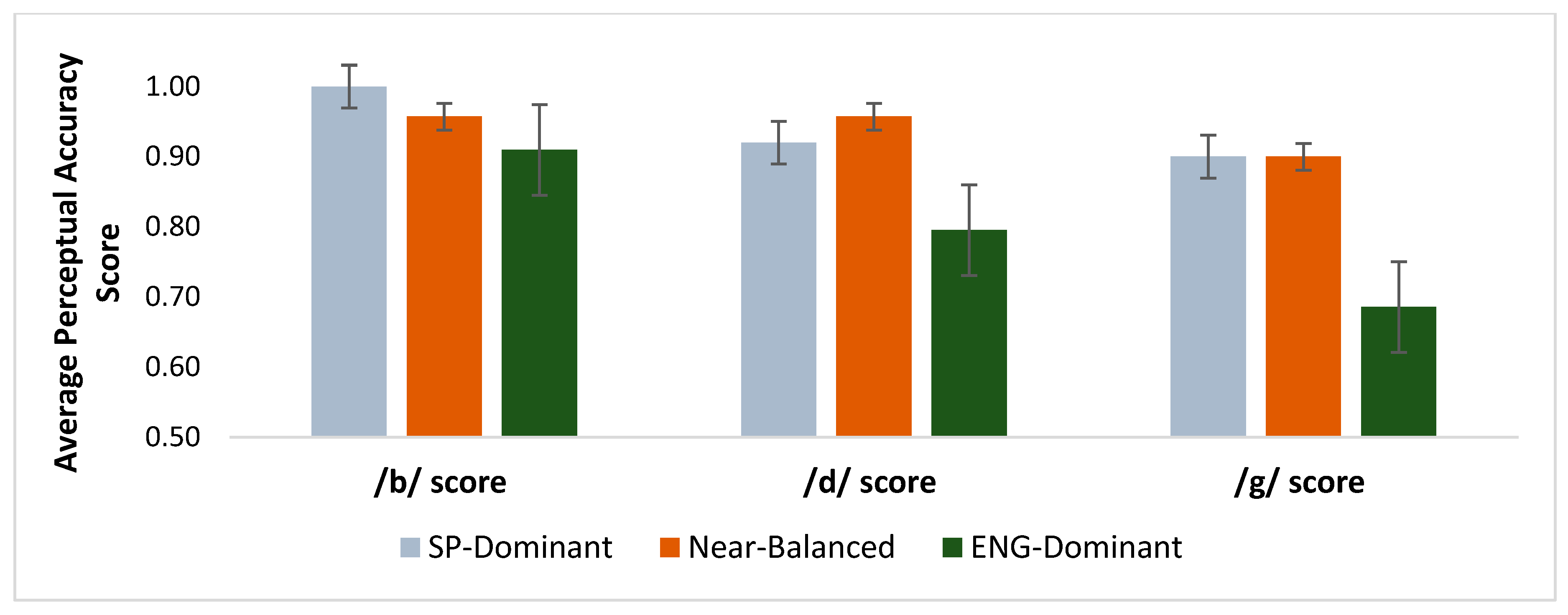Language Dominance Modulates the Perception of Spanish Approximants in Late Bilinguals
Abstract
1. Introduction
1.1. The Speech Learning Model
1.2. The Acquisition of Spanish Approximant [β], [δ], and [ɣ] by English-Speaking Learners
1.3. Language Experience in L2 Perception
1.4. Language Dominance in L2 Perception and the Bilingual Language Profile Questionnaire
1.5. Questions and Hypotheses
2. Materials and Methods
2.1. Participants
2.2. Tasks
3. Results
4. Discussion
5. Conclusions
Author Contributions
Funding
Acknowledgments
Conflicts of Interest
Appendix A

References
- Amengual, Mark. 2016. The perception and production of language-specific mid-vowel contrasts: Shifting the focus to the bilingual individual in early language input conditions. The International Journal of Bilingualism 20: 133–52. [Google Scholar] [CrossRef]
- Amengual, Mark, and Pilar Chamorro. 2015. The effects of language dominance in the perception and production of the Galician mid vowel contrasts. Phonetica 72: 207–36. [Google Scholar] [CrossRef] [PubMed]
- Amengual, Mark, and Miquel Simonet. 2019. Language dominance does not always predict cross-linguistic interactions in bilingual speech production. Linguistic Approaches to Bilingualism. [Google Scholar] [CrossRef]
- Aoyama, Katsura, and James E. Flege. 2011. Effects of L2 Experience on Perception of English/r/and/l/by Native Japanese Speakers. Journal of the Phonetic Society of Japan 15: 5–13. [Google Scholar]
- Bauer, Laurie. 2008. Lenition revisited. Journal of Linguistics 44: 605–24. [Google Scholar] [CrossRef]
- Best, Catherine T. 1995. Learning to perceive the sound pattern of English. Advances in Infancy Research 9: 217–17. [Google Scholar]
- Best, Catherine T., and Douglas Tyler. 2007. Nonnative and second-language speech perception: Commonalities and complementarities. In Language Experience in Second Language Speech Learning: In Honor of James Emil Flege. Amsterdam: John Benjamins Publishing Company, pp. 1–47. [Google Scholar]
- Birdsong, David. 2014. Dominance and age in bilingualism. Applied Linguistics 35: 374–92. [Google Scholar] [CrossRef]
- Birdsong, David, Libby M. Gertken, and Mark Amengual. 2012. Bilingual Language Profile: An Easy-to-Use Instrument to Assess Bilingualism. Austin: University of Texas at Austin. [Google Scholar]
- Bohn, Ocke-Schwen, and James Emil Flege. 1990. Interlingual identification and the role of foreign language experience in L2 vowel perception. Applied Psycholinguistics 11: 303–28. [Google Scholar] [CrossRef]
- Boomershine, Amanda, Kathleen Currie, Elizabeth Hume, and Keith Johnson. 2008. The impact of allophony versus contrast on speech perception. Contrast in Phonology: Theory, Perception, Acquisition 13: 145–72. [Google Scholar]
- Bouavichith, Dominique, and Lisa Davidson. 2013. Segmental and prosodic effects on intervocalic voiced stop reduction in connected speech. Phonetica 70: 182–206. [Google Scholar] [CrossRef]
- Brown, Gillian. 1990. Listening to Spoken English, 2nd ed. New York: Longman. [Google Scholar]
- Colantoni, Laura, Jeffrey Steele, and Paola Escudero. 2015. Second Language Speech: Theory and Practice. Cambridge: Cambridge University Press. [Google Scholar]
- Díaz-Campos, Manuel. 2004. Context of learning in the acquisition of Spanish second language phonology. Studies in Second Language Acquisition 26: 249–73. [Google Scholar] [CrossRef]
- Elliott, A. Raymond. 1995. Foreign language phonology: Field independence, attitude, and the success of formal instruction in Spanish pronunciation. The Modern Language Journal 79: 530–542. [Google Scholar] [CrossRef]
- Elliott, A. Raymond. 1997. On the teaching and acquisition of pronunciation within a communicative approach. Hispania 80: 96–108. [Google Scholar] [CrossRef]
- Escudero, Paola. 2007. Second language phonology: The role of perception. In Phonology in Context. New York: Palgrave Macmillan. [Google Scholar]
- Face, Timothy L., and Mandy R. Menke. 2009. Acquisition of the Spanish voiced spirants by second language learners. In Selected Proceedings of the 11th Hispanic Linguistics Symposium. Somerville: Cascadilla Proceedings Project, pp. 39–52. [Google Scholar]
- Flege, James Emil. 1987. The Production of “New” and “Similar” Phones in a Foreign Language: Evidence for the Effect of Equivalence Classification. Journal of Phonetics 15: 47–65. [Google Scholar] [CrossRef]
- Flege, James Emil. 1993. Production and perception of a novel, second-language phonetic contrast. The Journal of the Acoustical Society of America 93: 1589–608. [Google Scholar] [CrossRef]
- Flege, James Emil. 1995. Second language speech learning: Theory, findings, and problems. Speech Perception and Linguistic Experience: Issues in Cross-Language Research 92: 233–77. [Google Scholar]
- Flege, James Emil, Carlo Schirru, and Ian R. A. MacKay. 2003. Interaction between the native and second language phonetic subsystems. Speech Communication 40: 467–91. [Google Scholar] [CrossRef]
- Fox, Robert Allen, James Emil Flege, and Murray J. Munro. 1995. The perception of English and Spanish vowels by native English and Spanish listeners: A multidimensional scaling analysis. The Journal of the Acoustical Society of America 97: 2540–51. [Google Scholar] [CrossRef]
- Gertken, Libby M., David Birdsong, and Mark Amengual. 2012. Assessing Language Dominance through Self-Reports on the Bilingual Language Profile. Paper presented at the L2 Proficiency Assessment Workshop, Montpellier, France, February 24. [Google Scholar]
- Gimson, Alfred Charles. 1989. An Introduction to the Pronunciation of English, 4th ed. London: Edward Arnold. [Google Scholar]
- González-Bueno, Manuela. 1995. Adquisición de los alófonos fricativos de las oclusivas sonoras españolas por aprendices de español como segunda lengua. Estudios de Lingüística Aplicada 21: 64–79. [Google Scholar]
- González-Bueno, Manuela. 2019. Suggestions for Teaching Spanish Voiced Stops/b, d, g/and their Lenited Allophones [β̞, ð̞, ɣ̞]. In Key Issues in the Teaching of Spanish Pronunciation: From Description to Pedagogy. Edited by Rajiv Rao. New York and London: Routledge. [Google Scholar]
- González-Bueno, Manuela, and M. Quintana-Lara. 2011. Students’ awareness of Spanish spirantization allophonic rule. Paper presented at 2nd Pronunciation in Second Language Learning and Teaching Conference, Montpellier, France, September 10–11; pp. 180–98. [Google Scholar]
- Hazan, Valerie, Anke Sennema, Andrew Faulkner, Marta Ortega-Llebaria, Midori Iba, and Hyunsong Chung. 2006. The use of visual cues in the perception of non-native consonant contrasts. The Journal of the Acoustical Society of America 119: 1740–51. [Google Scholar] [CrossRef]
- Hualde, José Ignacio, Ryan Shosted, and Daniel Scarpace. 2011. Acoustics and Articulation of Spanish/d/Spirantization. Paper presented at 17th International Congress of Phonetic Sciences (ICPhS XVII), Hong Kong, China, August 17–21; pp. 906–9. [Google Scholar]
- Kissling, Elizabeth M. 2015. Phonetics instruction improves learners’ perception of L2 sounds. Language Teaching Research 19: 254–75. [Google Scholar] [CrossRef]
- Lavoie, Lisa. 2001. Consonant Strength: Phonological Patterns and Phonetic Manifestations. New York: Garland. [Google Scholar]
- Lord, Gillia. 2010. The Combined Effects of Instruction and Immersion on Second Language Pronunciation. Foreign Language Annals 43: 488–503. [Google Scholar] [CrossRef]
- Martínez-Celdrán, Eugenio. 2013. Caracterización acústica de las aproximantes espirantes en español. Estudios de Fonética Experimental 22: 11–36. [Google Scholar]
- Rafat, Yasaman. 2016. Orthography-induced transfer in the production of English-speaking learners of Spanish. The Language Learning Journal 44: 197–213. [Google Scholar] [CrossRef]
- Rafat, Yasaman, and Scott James Perry. 2019. The role of perception in learning Spanish pronunciation. In Key Issues in the Teaching of Spanish Pronunciation: From Description to Pedagogy. Edited by Rajiv Rao. New York and London: Routledge. [Google Scholar]
- Rao, Rajiv, ed. 2019. Key Issues in the Teaching of Spanish Pronunciation: From Description to Pedagogy. New York and London: Routledge. [Google Scholar]
- Vokic, Gabriela. 2010. L1 Allophones in L2 Speech Production: The Case of English Learners of Spanish. Hispania 93: 430–52. [Google Scholar]
- Warner, Natasha, and Benjamin V. Tucker. 2011. Phonetic variability of stops and flaps in spontaneous and careful speech. Journal of the Acoustical Society of America 130: 1606–17. [Google Scholar] [CrossRef]
- Zampini, Mary L. 1994. The role of native language transfer and task formality in the acquisition of Spanish spirantization. Hispania 77: 470–81. [Google Scholar] [CrossRef]



| Lang Hist | Lang Use | Proficiency | Attitudes | Overall Scores | |||||||||
|---|---|---|---|---|---|---|---|---|---|---|---|---|---|
| N | Sp. | Eng. | Sp. | Eng. | Other | Sp. | Eng. | Sp. | Eng. | Sp. | Eng. | Global Dom. | |
| Sp. Dom. | 5 | 50.7 (3.6) | 7.9 (6.9) | 46.0 (2.1) | 8.5 (2.1) | 0.0 (0.0) | 54.5 (0.0) | 32.7 (14.3) | 49.9 (8.9) | 14.5 (9.0) | 201.1 (10.9) | 63.6 (21.0) | 135.7 (15.3) |
| Near Bal. | 7 | 37.6 (18.0) | 20.2 (12.9) | 29.1 (14.9) | 24.8 (13.9) | 0.6 (1.2) | 49.0 (6.5) | 49.9 (5.1) | 42.5 (13.2) | 40.2 (11.0) | 158.2 (41.8) | 135.1 (37.8) | 23.0 (75.8) |
| Eng. Dom. | 21 | 2.8 (2.5) | 44.2 (3.0) | 2.9 (2.0) | 48.0 (5.6) | 3.6 (5.5) | 19.3 (9.8) | 54.0 (1.2) | 19.9 (11.3) | 53.4 (2.0) | 44.9 (21.6) | 199.6 (7.9) | −154.7 (22.2) |
© 2020 by the authors. Licensee MDPI, Basel, Switzerland. This article is an open access article distributed under the terms and conditions of the Creative Commons Attribution (CC BY) license (http://creativecommons.org/licenses/by/4.0/).
Share and Cite
Black, M.; Joanisse, M.F.; Rafat, Y. Language Dominance Modulates the Perception of Spanish Approximants in Late Bilinguals. Languages 2020, 5, 7. https://doi.org/10.3390/languages5010007
Black M, Joanisse MF, Rafat Y. Language Dominance Modulates the Perception of Spanish Approximants in Late Bilinguals. Languages. 2020; 5(1):7. https://doi.org/10.3390/languages5010007
Chicago/Turabian StyleBlack, Martha, Marc F. Joanisse, and Yasaman Rafat. 2020. "Language Dominance Modulates the Perception of Spanish Approximants in Late Bilinguals" Languages 5, no. 1: 7. https://doi.org/10.3390/languages5010007
APA StyleBlack, M., Joanisse, M. F., & Rafat, Y. (2020). Language Dominance Modulates the Perception of Spanish Approximants in Late Bilinguals. Languages, 5(1), 7. https://doi.org/10.3390/languages5010007




